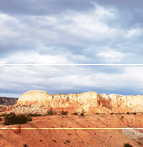Hiking and Fishing in the Abiquiu Region
The Abiquiu region presents outstanding opportunities for both hiking enthusiasts and anglers, offering everything from gentle desert walks to challenging mesa climbs, plus some of New Mexico's finest fishing waters. This diverse landscape provides adventures suitable for all skill levels, with well-maintained trails, spectacular scenery, and productive fishing spots that attract visitors from across the Southwest.
Plaza Blanca Hiking Access
Permission Required: You must ask permission from Dar Al Islam in advance before hiking the Plaza Blanca itself. Contact them via email at [email protected] to request access. The private landowner requires advance registration for all visitors, and access may be limited during certain times of year or weather conditions.
Plaza Blanca Trail Characteristics: The hike into Plaza Blanca itself involves walking through sandy washes and scrambling over smooth sandstone formations. The terrain is generally easy to moderate, but the lack of marked trails requires good navigation skills and awareness of flash flood potential during monsoon season. The formations offer numerous photography opportunities and exploration possibilities for those prepared with proper footwear and sun protection.
Ghost Ranch Trail System
Trail Access and Fees: Ghost Ranch offers some of the region's most spectacular hiking with well-maintained trails and excellent facilities. Day use fees are $10 per person and provide access to multiple trail options. The Welcome Center provides trail maps, current conditions, and safety information.
Chimney Rock Trail - Moderate Challenge
Trail Details: This 2.6-mile round-trip hike represents one of the most rewarding moderate trails in New Mexico. The route gains 715 feet of elevation as it climbs from 6,500 to 7,100 feet, leading to spectacular panoramic views from atop a dramatic mesa formation. The trail is well-marked and maintained, making it suitable for hikers with basic experience.
What to Expect: The initial portion follows a gentle incline through classic high desert terrain featuring juniper, piñon pine, and seasonal wildflowers. The final approach involves some rock scrambling to reach the mesa top, where hikers are rewarded with 360-degree views of Abiquiu Lake, the Chama River valley, and surrounding red rock formations. Allow 2-3 hours for the complete experience, including time for photography and rest at the summit.
Box Canyon Trail - Easy Family Option
Perfect for All Ages: This 4-mile round-trip trail offers the easiest hiking option at Ghost Ranch while still providing outstanding scenery and geological features. The gentle gradient and abundant shade make it suitable for families with children and less experienced hikers, even during summer months when other trails become uncomfortably hot.
Trail Features: The route follows a natural canyon through cottonwood groves and provides excellent opportunities for wildlife viewing, particularly bird species that inhabit the riparian environment. Interpretive signage along the trail explains the area's geology, ecology, and cultural history. The shaded environment and seasonal water sources create a microclimate that supports diverse plant and animal life.
Kitchen Mesa Trail - Advanced Challenge
Serious Hikers Only: This 6.2-kilometer trail (approximately 3.9 miles) represents the most challenging hike available at Ghost Ranch, requiring good physical condition and hiking experience. The route involves significant elevation gain and technical sections that demand careful footing and endurance.
Rewards for Effort: Those who complete this demanding hike are rewarded with some of the most spectacular views in the region, including vistas of the entire Chama River valley and distant mountain ranges. The trail provides access to geological formations and ecological zones not visible from easier routes, making it particularly valuable for serious photographers and nature enthusiasts.
Additional Hiking Opportunities
Echo Amphitheatre Trail
Natural Wonder Access: The short walk to Echo Amphitheatre provides easy access to one of the region's most unique geological features. This 5-minute walk from the parking area leads to a natural sound chamber where visitors can experience remarkable acoustic effects while enjoying dramatic red rock scenery.
Santa Fe National Forest Trails
Managed Trail System: To the south of Abiquiu, the Santa Fe National Forest offers numerous maintained hiking trails with varying difficulty levels. These trails provide access to higher elevation environments, different ecological zones, and cooler temperatures during summer months. The Forest Service maintains current trail conditions and provides detailed maps through their Española Ranger District office.
Monastery of Christ in the Desert Access
Remote Canyon Hiking: The 13-mile drive to the Monastery of Christ in the Desert provides access to primitive hiking opportunities along the Chama River. These unmarked routes require self-sufficiency and navigation skills but offer exceptional solitude and wildlife viewing opportunities in one of New Mexico's most remote accessible canyons.
Fishing at Abiquiu Lake
Premier Northern New Mexico Fishery: Abiquiu Lake ranks among New Mexico's top fishing destinations, offering diverse species, excellent facilities, and consistent productivity throughout the year. The 4,400-acre reservoir provides both bank and boat fishing opportunities in a spectacular high desert setting surrounded by colorful cliffs and mesas.
Target Species and Fishing Techniques
Rainbow Trout: The lake's cold, clear waters support healthy populations of rainbow trout, with fish typically ranging from 12-16 inches and occasional trophy specimens exceeding 20 inches. Spring and fall provide the best trout fishing, with early morning and evening hours proving most productive. Trolling with spoons or spinners works well, as does still-fishing with PowerBait or nightcrawlers near drop-offs and structure.
Walleye: Abiquiu Lake's walleye population has grown significantly in recent years, providing excellent opportunities for both quantity and quality fishing. These fish typically range from 14-18 inches with some exceeding 22 inches. Walleye respond well to jigs tipped with minnows or worms, particularly around rocky points and submerged structure during dawn and dusk periods.
Smallmouth Bass: The rocky structure and clear water create ideal smallmouth bass habitat, with fish averaging 12-15 inches and providing exciting sport on light tackle. Spring spawning periods offer the best bass fishing, with topwater lures, jigs, and soft plastics all producing consistent results around rocky shorelines and submerged boulders.
Additional Species: The lake also supports populations of brown trout, crappie, and occasional tiger muskie, providing variety for anglers willing to experiment with different techniques and locations.
Fishing Regulations and Licenses
License Requirements: All anglers 12 years and older must possess a valid New Mexico fishing license. Licenses are available online through the New Mexico Department of Game and Fish website, at sporting goods stores, and at some local businesses. Daily licenses are available for visitors not planning extended fishing trips.
Bag Limits and Regulations: Trout and salmon have a combined bag limit of 5 fish, with specific restrictions on certain species. Smallmouth bass regulations follow standard New Mexico warm-water fish rules. Always check current regulations before fishing, as limits and seasons can change based on fish population assessments and management objectives.
Fishing Access and Facilities
Bank Fishing Opportunities: Multiple access points around the lake provide bank fishing opportunities, with developed areas offering parking, restrooms, and picnic facilities. The dam area and boat ramps provide some of the most accessible fishing, while more remote shoreline areas offer solitude for those willing to hike.
Boat Launch Facilities: The lake features multiple boat ramps managed by the U.S. Army Corps of Engineers, with the main ramp providing excellent access for larger boats and trailers. Smaller craft can launch from additional locations around the lake, providing access to productive fishing areas and scenic coves.
Seasonal Planning and Safety
Best Times for Hiking
Optimal Seasons: Spring (March-May) and fall (September-November) provide the most comfortable hiking conditions with moderate temperatures and minimal precipitation. Summer hiking requires early morning starts and adequate water supplies, while winter hiking demands proper cold-weather gear and awareness of ice and snow conditions.
Best Times for Fishing
Peak Fishing Periods: Spring and fall offer the most consistent fishing success as water temperatures moderate and fish become more active. Summer fishing can be excellent during early morning and evening hours, while winter fishing requires targeting deeper water during the warmest parts of sunny days.
Safety Considerations
Weather Awareness: High desert weather can change rapidly, particularly during monsoon season (July-September) when afternoon thunderstorms create flash flood risks in washes and canyons. Always check current weather forecasts and carry emergency supplies including extra food, water, and signaling devices.
Navigation and Communication: Cell phone coverage is spotty or non-existent in many hiking areas, making GPS devices and offline maps essential for navigation. Inform others of your hiking plans and expected return times, particularly when exploring remote areas or attempting challenging trails.
Wildlife Precautions: The region supports populations of black bears, mountain lions, and rattlesnakes. Proper food storage, awareness of surroundings, and knowledge of appropriate responses to wildlife encounters are essential for safe outdoor recreation.
Essential Gear and Preparation
Hiking Equipment: Sturdy hiking boots, sun protection (hat, sunglasses, sunscreen), plenty of water (1 gallon per person per day minimum), and layered clothing appropriate for changing conditions. See our what to wear guide for detailed clothing recommendations.
Fishing Gear: Medium-weight spinning gear suitable for both trout and bass, variety of lures and baits, landing net, and cooler for keeping fish fresh. Boat fishermen should include safety equipment, navigation aids, and communication devices.
The combination of spectacular hiking trails and productive fishing waters makes the Abiquiu region a premier destination for outdoor enthusiasts. Whether seeking challenging mesa climbs, gentle family walks, trophy fishing, or peaceful solitude, this remarkable landscape provides unforgettable experiences for properly prepared visitors.
Plaza Blanca Guide -
How To Get Here -
Unofficial guide. Not associated in any way with the Dar Al Islam
Center or Georgia O'Keeffe's estate
|









